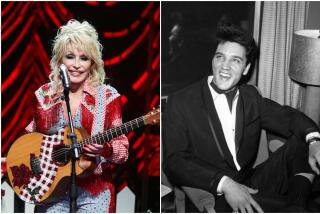Listening to New Variations of Elvis
- Share via
Two dozen years after Elvis Presley’s passing, a prodigious amount of his material continues to be released, with a few new titles each year.
The latest is a four-disc overview of his casino recordings, “Elvis: Live in Las Vegas” (RCA), a field one would think has been pretty well covered, especially with the release of the three-disc “Elvis: That’s the Way It Is--Special Edition” to coincide with the re-cutting of the concert film of the same name.
But because Presley played two shows nightly for his stints of up to four weeks, there are scores of different performances of some songs.
And, says Michael Omansky, senior vice present of strategic marketing for RCA who oversees the Presley catalog, “the hard-core fans want every performance. Any variation of a song is almost a new song to them.”
Of the 86 recordings on the “Live in Las Vegas” set, 53 of them have been previously unreleased. And two songs have never appeared on any Elvis recording--a cover of Bobby Darin’s “You’re the Reason I’m Living,” in March 1975, and a version of Ed Ames’ “When the Snow Is on the Roses,” from what seems to be an audience recording in August 1970.
There’s history there, Omansky says. “Unless you were there in Las Vegas, you didn’t hear them before.”
Though he had his greatest successes in 1969 and the early ‘70s, the box includes a handful of recordings from his less successful 1956 stint, when as a 21-year-old at the top of the charts he and his spare band were opening for Shecky Green.
The boxed set starts with a complete show from Aug. 24, 1969, that represents what Elvis says is “my first appearance in nine years live.”
“I appeared dead a few times,” he adds, sardonically, “but this is my first live performance.”
Much of the Elvis material was professionally recorded, but some of the tracks came from unusual sources.
“We’re constantly looking for unreleased stuff,” Omansky says. “We’re always acquiring more tapes people find that have walked away from the studio somehow.”
Some newly found tapes were acquired earlier this summer, he says. “We’re on the case to pick up 16 tapes of studio work from the ‘50s to the ‘70s.”
With what it has already amassed, RCA can keep issuing recordings with previously unreleased material until 2006, Omansky says.
The next one, however, “50 Elvis Love Songs,” a double-disc album due out next month, is aimed at a more mainstream audience. Among the TV marketing plans was an appearance by Omansky on the QVC network, which took advance orders for the set last Thursday, the 24th anniversary of Presley’s death.
In the wake of the 7-million-selling success of “The Beatles 1,” RCA will be issuing its own collection of 30 No. 1 Elvis hits on one disc next year.
Sure, many buyers will have had the hits already, Omansky says. “But to have it all in one place at one time is pretty appealing.”
Besides the traditional Elvis audience--”which skews female and skews Southern”--there is every indication that Elvis is getting new fans. “Statistics at Graceland show that the attendance there by those 18 and under has been up for the last five years, which means their parents are indoctrinating the next generation of fans,” Omansky says.
Also, Elvis marketing has broadened. At Christian bookstores, a two-disc gospel collection has sold 200,000 copies. A number of other sales were marked in the first single-artist series by Time-Life.
One of the things Omansky did when he took over the catalog five years ago was to streamline the number of titles to avoid overwhelming customers.
Among those cut were the “Essential Elvis” series of studio outtakes and chatter, which he says served such a rarefied audience, “it was a niche of a niche.”
*
Catlin is rock music critic for the Hartford Courant, a Tribune company.
More to Read
The biggest entertainment stories
Get our big stories about Hollywood, film, television, music, arts, culture and more right in your inbox as soon as they publish.
You may occasionally receive promotional content from the Los Angeles Times.










